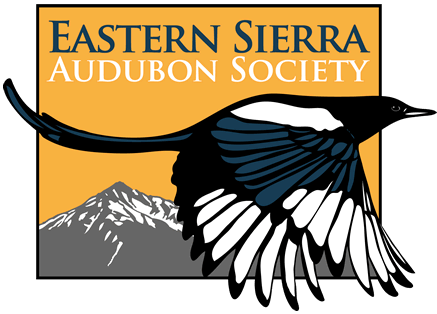[Originally appeared in the Sierra Wave newsletter, Vol. 27, No. 2, Nov-Dec 2008 – click here for original with photos]
Longspurs are a small group of small LBJs, a.k.a. “little brown jobs,” closely related to sparrows in the family Emberizidae. They get their name from the long hind claw they and Horned Larks have. There are four species in North America with the Lapland and Smith’s breeding in Alaska and Canada and the McCown’s and Chestnut-collared in the northern Great Plains. Winter finds all but the Lapland in the south-central states; the Lapland prefers the northern tier states as well as the Pacific Coast. All four longspurs have been documented in the eastern Sierra.
During the breeding season, males are brightly colored and distinctive but when they occur in our area they seldom have bright feathers to help in identification. This task is not for the faint-hearted as recognized by Allen R. Phillips, a famous ornithologist, who advocated a half century ago that the best way to identify them was with a 12-gauge shotgun! Fortunately we have learned much since those days and now know what, where, and when to seek as well as what they sound like as they call while flying overhead.
The Chestnut-collared Longspur is an uncommon fall migrant and casual, less than annual, winter visitor and spring migrant to the eastern Sierra. The vast majority of records are from late September to early December with an early outlier on 5 Aug (M.A. Patten, American Birds 44:165). Since the species was first recorded in Inyo County, 28 Sep 1917 near Darwin (Grinnell, Condor 20:87), it has been recorded all months except June and July…when they are bright and pretty!
The Lapland Longspur is a very rare fall migrant with about fifty records most in October and November plus two in winter and two more in spring. The earliest fall record is a photographed bird 12 Oct (2008 at Owens Lake, T&J Heindel). This is only one day earlier that the first time it was ever recorded in Inyo County on 13 Oct 1949 at Deep Springs Lake (McLean, Condor 71:434).
The McCown’s Longspur has been recorded just six times since it was first found in Inyo on 16 Oct 1949 near Deep Springs Lake (ibid.). All records are between 16 Oct and 11 Nov. The last one added to the county list was ten years ago when Andrew and Leah Kirk found and we photographed it east of Independence.
The Smith’s Longspur, a casual vagrant, is represented by a single record when it was viewed and photographed by the most active birders in the state from 4-11 Oct 1997 at Furnace Creek Ranch.
So how do you find longspurs? Know when to look – October and November are optimal. Know where to look – primarily grasslands, cut alfalfa fields, dry lakebeds and golf courses. Know what to look for – primary extension, bill size and shape, tail pattern, wing covert color, breast color and streaking. The Sibley Guide and the National Geographic Field Guide to the Birds of North America both discuss identification characteristics of each species well. Know the calls – Chestnut-collareds give a distinctive “kittle-kittle” while Laplands give a descending “tew” as well as a rattle. All four longspur vocalizations are on “Bird Songs of the Rocky Mountain States and Provinces” by Righter and Keller. If you see flocks of Horned Larks, look and listen carefully since longspurs hobnob with the other “long, hind claw species.” This chunkier bird often flies to the side or above the larks. Know the calls and listen for a different call or look for white flashes in the tail as the flock whirls. If you find a rare longspur be ready and willing to validate it by immediately notifying others with more experience and photographing it if possible.
Tags: lark, longspur, sparrow
